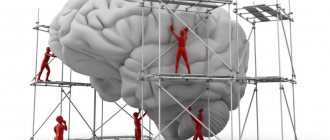Psychotherapy Gestalt therapy was founded in the mid-twentieth century by the German psychologist Friedrich Perls, but it has gained the greatest popularity recently.
The name of this direction comes from the German concept of Gestalt - “finished”, “something whole”, “image”. This is precisely what determines the main principle of the above-mentioned direction: the whole cannot be perceived as the sum of its parts. Simply put: the perception of a person’s face is not reduced to the total perception separately of his eyes, nose, mouth, etc.
The “Gestalt Spirit” does not accept the norm, because every person is special, he has the right to be different from others and completely unique.
Gestalt, without going into the professional specifics of psychological science, is an image of the situation as a whole. To be closer to the academic definition, this is a holistic structure of human interaction with the environment, including the distance between the emergence and satisfaction of a need.
Exercises and techniques of Gestalt therapy “Integration of polarities”
Technique “Integration of Polarities”. Exercises for Gestalt therapy in group and individually.
Exercise “Role Playing”
At the suggestion of the therapist, group members take turns playing out their intrapersonal conflicts, which they are not fully aware of, but are obvious to others. For example, if a participant, without noticing this, apologizes too often, speaks in a quiet voice, or is embarrassed, then he can be asked to play the role of a shy, timid young man. At the same time, he is asked to somewhat exaggerate precisely those character traits that are especially pronounced in him.
If the participant is aware of his behavior and wants to get rid of it, he can be assigned to play the role of a person with opposite character traits, for example, Khlestakov or the Chief, who speaks to subordinates only in a tone of orders and moralizing.
Each participant is given 5–10 minutes to role-play. The rest of the time should be left for sharing impressions.
Exercise 2. “Struggle of opposites”
The psychotherapist determines the topic of discussion, then assigns one of the participants the role of the Attacker, the other the Defender. Participants sit facing each other and begin a discussion. Each participant must remain committed to their role. The attacker must criticize the partner, scold him, lecture him, speak in a firm authoritarian voice. The Defender - apologize, make excuses, explain why he cannot do everything that the Attacker requires of him.
The discussion lasts 10 minutes. After this, the partners change roles. Each participant in the dialogue needs to understand as fully and deeply as possible the feeling of power, aggression of the Attacker and the feeling of timidity, humiliation, and insecurity of the Defender. Compare the roles you have played with your behavior in real life. Discuss the experience with the group.
Exercise 3. “Antique store”
Sit on a chair, close your eyes, relax. Imagine that you are in a store that sells antiques. Mentally choose any object for yourself and imagine yourself with this object. Tell us about yourself on behalf of this subject: how you feel; why were you in the store? who and where is your previous owner, etc. Open your eyes and share your feelings with the group.
In the same way, you can identify with a flower, a tree, an animal, imagining yourself in the appropriate conditions. Don't be shy about your feelings. Try not to have any unfinished experiences.
Exercise 4 “Two chairs”
Often a person feels some duality, splitting by opposites, feels himself in a conflict of these opposites, opposing forces. You are invited to play a dialogue between these parties .
With each role change, you will switch chairs: the “friendly self” and the “irritated self.”
The role played may be the role of the person as he is now; the role of a child, mother, father, spouse or boss. The role can be a physical symptom - an ulcer, headache, lower back pain, palpitations. It could be an object encountered in a dream, for example, a piece of furniture, an animal, etc.
Learn more about the Empty Chair technique
Exercise 5 “Working with a name”
The sense of identity develops under the influence of the environment. This is a reaction to impacts and influences addressed to a person. Even the name or names that are written down in documents influence fate. They reflect parental expectations aimed at the child, cultural and historical background, often the history of the family or the history of the country. In addition to the official name, a person bears children's names, nicknames and nicknames - those that his relatives and parents called him in childhood, as he is now called by close people or enemies.
Several exercise options are offered that can activate the feelings associated with the name and the relationships associated with the name in the childhood family.
Different exercises, highlighting different figures, allow you to focus on different aspects of one large topic. There is no point in doing them in a row, but it is worth choosing the ones that are suitable for a given session.
Remember the names and nicknames you were called as a child. Who gave you these names, in what circumstances were you called by this or that name? Who called? How do you feel now when you think about these names?
Choose the most striking baby names. What feelings did they evoke? Connect with the projection. Experiment now. What feelings did this name express? How did those who gave you this name or nickname treat you? Play out scenes with your partner.
What are your nicknames or pet names now? Where did they come from? What areas of life do they affect?
Do you have different names at home and at work? If yes, what is the reason for this? Remember your names (definitions, characteristics) at different periods of your life. How did they influence or influence your self-image now?
Introduce yourself in a circle with three different names, accompanying each with the appropriate intonation and pantomime. Remember the attitude towards your name at different periods of your life. How did it change? Were you proud of it, did you love your name – or were there periods of negativity? What are your current name options? In what situations do they call you this way, when do you introduce yourself this way, to whom, where? What feelings do you associate with these names? What is your relationship with people who call you that?
Have you ever been called a name that is inappropriate or derisive for your gender? How did your parents choose your name? In honor of whom? Their expectations - what do you know about them? What is the symbolic meaning of your name, what does it mean in translation, what did it mean to you at different periods of your life.
How do you feel about your name among others? How do you feel about those with the same name: do you feel good or do you have negative feelings when there are other people with the same name? If your name is unique, how do you feel among those who have an ordinary name?
If you were choosing a name for yourself again, what name would you choose and why, what could it symbolize? What are the arguments for keeping the old name? What are the reasons for choosing a new one?
Be aware of how you introduce yourself – for example, in a given group; what they call you - the way you introduced yourself or otherwise. How do you react to this? What do you prefer to be called, who and when? What variations of your name do you dislike?
(For married women.) How has changing or keeping your maiden name after marriage, divorce, or widowhood affected your identity? Whose last name you bear and why – what does it mean to you? If your last name is different from your husband's last name, how do people react to this?
Share link:
- Click here to share content on Facebook. (Opens in a new window)
- Click to share on WhatsApp (Opens in new window)
Similar
Education
Gestalt therapy is a complex direction in psychology, with a philosophical and humanistic bias, and in order to study it, it is practically necessary to learn from professionals.
These days, training courses can be taken in educational institutions: full-time, part-time, and even online.
In Moscow, lectures and master classes from professors, associate professors and leading experts are offered by the Institute of Gestalt Therapy and centers for advanced training in the field of psychology. Those interested can get acquainted with both the basic concepts of the Gestalt method and its subtleties.
The training is organized in such a way that theory and practical work alternate, which allows group members to consolidate knowledge through personal experience of participating in psychotherapeutic classes.
Studying Gestalt therapy is necessary:
- for specialists who plan to use this method in their practice;
- for psychotherapists who want to work on their own problems;
- for practicing psychologists and psychiatrists who want to expand their knowledge of the profession.
Duration of training is from 3 to six months. The cost ranges from ten to forty thousand rubles, depending on the duration and content of the training programs.
Video:
Appointment with a Gestal therapist
The key point of visiting a specialist using the Gestalt method is a direct conversation between the doctor and the client.
Rules for visiting a specialist:
- it is necessary to listen carefully to everything the patient wants to tell;
- the nature of the conversation should not pit the psychologist and the client against each other;
- communication must be conducted on equal terms, like ordinary interlocutors, with your own baggage of practical knowledge and perception;
- the time of the visit and the duration of the visit should be agreed upon in advance;
- the room should be chosen without strangers;
- It is better to conduct therapy behind closed doors.
The main goal of psychotherapy is to teach your client to truthfully express his desires and feelings. He must learn to correctly assess events and surroundings, and get rid of depression.
Learning can be compared to teaching, first repeating the skills learned, then learning new material.
The client must find the answer to the question: “What should I do to make changes happen?” The problem is that it is our sensations and feelings that express our real capabilities.
We are often afraid of something, or feel insecure, or are offended by someone. Many people are hampered by unspokenness, suppression from management, etc. All this only prevents you from taking a step towards performing an action in order to satisfy your own needs.
The psychologist is obliged to determine the reason why the client cannot get rid of his numerous phobias and fears. This will lead to an understanding of how to develop and what needs to be changed in character and environment.
It should be noted that they are discussing “correct” desires. To implement them there is no need to break laws or infringe on the freedom of others. Often they come to the appointment with serious problems of loved ones and relatives. A specialist is not able to influence this (grief, serious illness).
2.1. Try to focus on food at least once a day
Give up the usual socialization (essentially distraction) while eating - reading, watching TV, socializing.
The dog that grabs the bone tries to get privacy with it. At this moment, nothing is more important for her than gnawing, chewing, swallowing.
For the sake of experiment, become a dog for half an hour.
Pay attention to how you do this. Learn to eat. We warn you: you won’t learn it right away - it will take two months, no less.
Monitor your feelings, inhibitions and resistances.
How soon do you stop tasting what you eat? Does loss of taste coincide with bouts of thinking and inner talking?
Are you able to bite (do you tear off a piece of, for example, a roll with your teeth, or clench your teeth and tear the bread from the piece clenched by your teeth with your hand?)
What do you experience when you eat - impatience, greed, disgust, the desire to stop it all as soon as possible?
If you don’t like the food - it’s bland, tasteless - do you refuse to eat or swallow it in a hurry, not paying attention to the taste and smell?
The answers to these questions contain answers to how you would naturally eat, as well as the opportunity to return to active processing and assimilation of food, to that method and action that was once interrupted and suppressed.
Reviews
Patient Maria:
I attended group classes for about a month. There I met people who had similar problems to me. At first it was strange to give way to feelings, but gradually I realized that with emotions the negativity goes away. I began to allow myself much more in real life, learned to rejoice like a child and live in harmony with myself.
Patient Olga:
I didn’t quite believe that practical psychology could save me from tightness and constraint. But it was thanks to Gestalt therapy that I was able to love myself and do what I had long wanted. I understood the difference between my desires and the standards of behavior imposed on me. It’s such freedom to act according to your feelings and not hide them!
Patient Alena:
I became “comfortable” with myself, my anxiety and stiffness went away. I am calmer than ever, cheerful and value myself.
Patient Vladimir:
It was a very strange experience for me. I realized that the feelings that are inside me are much more “voluminous” and richer than their external manifestations. I stopped being embarrassed by them and started talking about them to my wife. We became much closer, it turns out she always really wanted me to tell her about love. My life has really changed - it has become brighter!
Patient Marina:
I'm glad I went through therapy. Only then did I realize that those around me, with their manipulations, almost turned me into a neurotic. The realization that I could live my life and emotions did not come immediately, but this path returned my health, both mental and physical.
Technique “Identification with external objects”
Allows you to identify hidden mental conflicts.
It happens that when a person is outraged by something or someone, as a rule, he talks about himself, and not about someone else.
Relax. Let go of your consciousness. Highlight everything you pay attention to. Maybe you're coming back to something? Focus on this. What does it represent? What are its main signs? Highlight the details. Now identify with it. Be like him. You are it.
What are you like now? What properties, traits, features do you have? Describe yourself. Say it out loud - I... What are you doing? What is your purpose? What exactly is your experience of identification with this object? Become aware of this experience.











